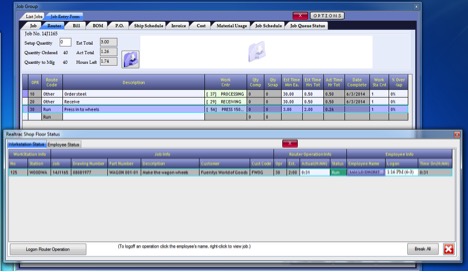Realtrac’s World Headquarters are based in Livonia, Michigan,
and are part of the “MMS 2014 Top Shop”-awarded, Delta Research Corp. But the
development team needs to know what software and features the marketplace
needs… and this guidance comes from the Realtrac Steering Committee.
The Realtrac Steering Committee is made up of Customer
Machinists, Customer Management teams, members of the ownership, and Realtrac sales
and marketing teams. All of these committee members are influential in the
process of deciding which features and functions should be included in the
system. The Realtrac sales and marketing team is the driving force of the
committee, as they are on the front line of customer requests and inquiries.
While Realtrac’s parent company, Delta Research, Corp.,
heads the steering committee, Realtrac enjoys a hands-on approach to acquiring
information for best machine shop practices. One example: in preparing for the
2014 tax season, the Realtrac Steering Committee, along with one prime customer
of Delta Research, decided to invest development resources to make it easier
for Realtrac users to claim their fair share of the United States Federal
Research and Development tax credit. The sales and marketing team confirmed
they had requests from their customers for this feature. We knew that what was
good for one user could benefit many Realtrac users.
In general, a development team will break a New Feature
request like this into two broad categories: Input (what information we should
allow the user to enter into the Realtrac Performance ERP system), and Output (what
reports and forms the system needs to generate to achieve the desired result).
Input-wise, we already had mechanisms in place to capture
costs. Shop floor employees log in and out of jobs on a daily basis, so we
already knew exact labor costs, as well as when they happened. Within our
database we know down to the penny how much was spent on labor over the course
of a company’s fiscal year. Not all jobs run through a shop are eligible for
the tax credit, but the Realtrac job tagging mechanism already provided the
perfect way to flag a job. While the development team went to work, we simply
asked the Realtrac user to begin adding the tag "RD14" to jobs they
believed were eligible for the credit.
Output-wise, we determined that two new reports were
necessary. We developed a report that broke down every employee’s labor hours
and costs for R & D jobs over the course of the company’s fiscal year. The
second report examined the buyout/material expenses related to the R & D
jobs. These two reports—produced with a click of a button in the Realtrac
Performance ERP software, along with a simple “org” chart and a breakdown of
administrative costs—were all that the Realtrac users’ accountants needed to
prepare the claim.
Every step of the way, the Realtrac development team was
working hand-in-hand with the Realtrac Steering Committee, Delta Research, and
a third-party tax and accounting consultant the Steering Committee brought in
to help guide the development process.
The best moment of the whole process? One very satisfied
Realtrac customer who filed their claim for hundreds
of thousands in credits. Their 2014 tax return is complete, and their
Realtrac system has already been capturing costs for their 2015 return. Completing
the claim next year is going to require no extra work. They’ll just need to tag
eligible jobs and run the report at the end of the year!
Admittedly, the second best moment of the process was when the
tax consultant said the Realtrac Performance R&D reports were the most
complete, simplest presentation of the required documentation and information
they have received from any software product, ever.
To all of our
existing customers — please continue talking with Realtrac and your sales
reps about what's going on in your business. What challenges can we help you with?
What information do you need to help drive your business, improve sales, or cut
costs?
Keep an eye on our social media and website—the R&D
Feature is being officially released in our September, 2015 update; plus, we
will be releasing a training video showing how the feature works, and helping
get our users ready to file their 2015 claims.
To all of our future
customers — keep this narrative in mind when deciding on your future ERP
system. These formal conversations
between the Realtrac Development team and the Steering Committee occur weekly
and even daily, informally.
Realtrac is unique in that it’s guided on a daily basis by a
machine shop. So, features that benefit the Delta Research shop are very likely
to benefit your machine shop.
Give Realtrac a call. We can set you up with a complete
machine shop ERP system, including a great new feature that will automate the
process of applying for your Federal Research and Development tax credit—all in
under a week!













